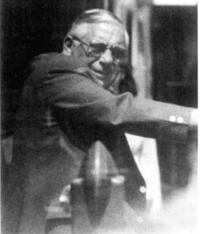Five Families: The Rise, Decline, and Resurgence of America's Most Powerful Mafia Empires (56 page)
Authors: Selwyn Raab

Resplendtly dressed, a smiling, confident-looking John Gotti is photographed for mug shots upon his arrest on new RICO charges in December 1990. That same night, Underboss Salvatore “Sammy the Bull” Gravano (left) is visibly downcast.
(Photos courtesy of the Federal Bureau of Investigation)


After his arrest, John J. Gotti designated his son, John Angelo Gotti, as acting Gambino boss. Known as “Junior,” the son proved to be an unwise choice and a poor leader who was imprisoned for racketeering. He was indicted again in 2004 on a charge of ordering a botched hit on radio personality Curtis Sliwa.
(AP/Wide World Photos)

Peter Gotti, lecturing an underling, became boss of the Gambino family after his nephew, “Junior,” was convicted. Arrested soon after becoming boss and blind in one eye, he was imprisoned on racketeering charges and for plotting to murder Salvatore “Sammy the Bull” Gravano for betraying his brother.
(Photos courtesy of the Federal Bureau of Investigation)

J. Bruce Mouw (left) devised the FBI’s long-range game plan that ended John J. Gotti’s reign as America’s most notorious Mafia godfather. Despite Gotti’s courtroom attempts to rattle him, a youthful John Gleeson (right) was the lead prosecutor who convicted the mob icon.
(Photo courtesy of U.S. Department of Justice)

Government officials in New York. (From left to right): Jim Fox, the head of the FBI’s regional office; William Doran, the FBI’s criminal division supervisor; and Andrew Maloney, the U.S. Attorney for the Eastern District, celebrate Gotti’s guilty verdict. Maloney fought off attempts by federal and state prosecutors in Manhattan to wrest the Gotti case from his jurisdiction.
(Photo courtesy of U.S. Department of Justice)

Antonio “Ducks” Corallo was anointed boss of the Lucchese family in the late 1960s. A predecessor, Tommy “Three-Finger Brown” Lucchese pinned the nickname Ducks on Corallo for his finesse in evading prison sentences.
(Photo courtesy of the New York City Police Department)

Vittorio “Little Vic” Amuso (in an early mug shot) succeeded Corallo as Lucchese boss, marking the first time the family’s Brooklyn wing gained control. Amuso delegated wide powers to his sidekick and underboss, Anthony Casso.
(Photo courtesy of the New York City Police Department)

Anthony Casso, aka “Gaspipe,” outside La Donna Rosa Restaurant, a Lucchese hangout in Little Italy, across the street from a memorial to slain Mafia detective Joe Petrosino. As underboss and, in effect, the Lucchese’s leader, Casso began dressing and] more elegantly, spending $30,000 on a one-day clothes shopping spree and $3,000 for a bottle of wine.
(FBI and NYPD Surveillance Photos)

Peter “Fat Pete” Chiodo (right), once Casso’s bosom pal, was marked for death by him in a purge of suspected disloyal mobsters. Although shot twelve times, Chiodo survived and doctors credited his obesity for saving his life.
(FBI Surveillance Photo)

The classic Mafia success story, Anthony “Tumac” Accetturo became a multimillionaire overseeing the Lucchese family’s rackets in New Jersey and Florida. Accetturo defected to the government’s side in 1994, claiming that Casso and Amuso attempted to kill him and relatives over money disputes.
(Photo courtesy of William Sauro)
